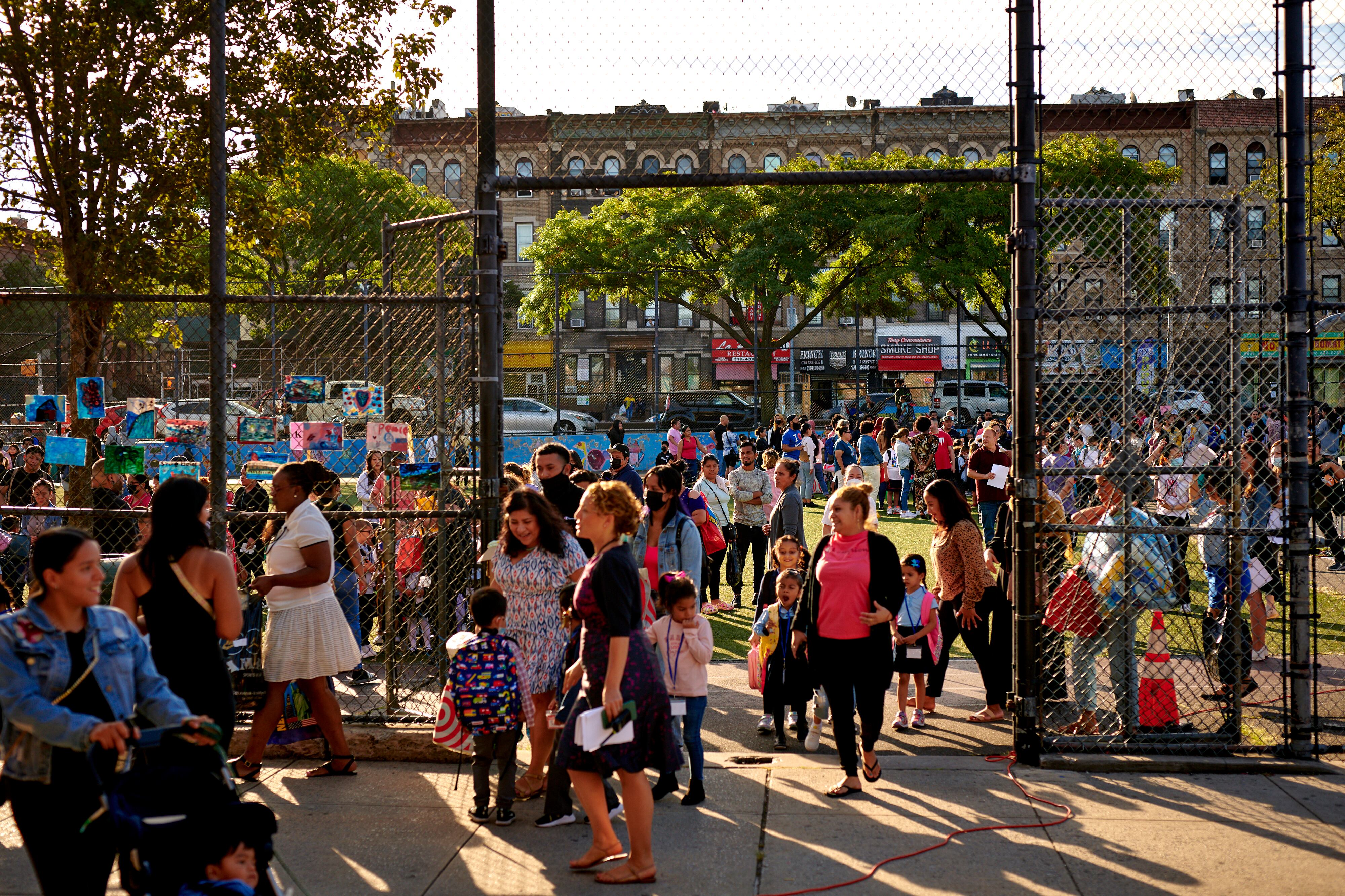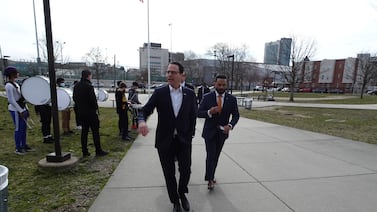Sign up for Chalkbeat New York’s free daily newsletter to keep up with NYC’s public schools.
After months of deliberation, internal clashes, and comments from nearly 2,000 people, a working group tasked with advising New York City’s public schools on complying with a landmark state law capping class sizes released its final recommendations Monday.
The 55-page report, which had an initial Oct. 31 deadline, includes more than 50 recommendations. Its prominent suggestions include capping enrollment at some overcrowded schools, moving pre-K programs out of district buildings and into community organizations, and offering financial incentives to boost teacher hiring.
The report, which is similar to a draft version released in September, is non-binding. Education Department officials still have final say in how they’ll meet the new legal mandates, which are expected to be phased in over the next five years. But the contentious process of putting the recommendations together illustrates how complicated meeting the new mandates will be.
The caps require K-3 classes to be no larger than 20 students, classes in grades 4-8 to be smaller than 23 students, and high school classes to be capped at 25 students.
Proponents of the law, including a wide array of parents, advocates, legislators, and educators, point to extensive research on the educational benefits of lower class sizes — and argue that the new recommendations give the city a clear roadmap for how to get there.
“Given these actionable proposals — many of them cost-free — the Chancellor no longer has any excuse for delay,” said Leonie Haimson, working group member and executive director of Class Size Matters, in an email. “If the DOE really cares about following the law and the goal of providing all NYC students with a better opportunity to learn, the time for action is now.”
But the law has also prompted fierce pushback from city Education Department leaders, who argue they don’t have the necessary funding to implement it. Parents concerned the law could restrict enrollment at sought-after schools and advocates worried about equity implications have also criticized the law.
Several studies suggest that the highest-poverty schools will benefit less because they are already more likely to have classes under the legal cap.
The working group’s deliberations got so contentious that nine of the working group’s 46 members declined to endorse the final recommendations — and several even authored a dissenting “minority report.” Those dissenters argue that the law itself is deeply flawed.
Dia Bryant, the former executive director of Education Trust-New York and one of the dissenters, said the law and the working group ignored practical concerns and are “very aspirational.”
“Ultimately, I think the implementation under the current conditions … is just bad for kids,” Bryant said.
In response to the report, schools Chancellor David Banks noted the city is currently in compliance with the class size law, but that “the work to remain in compliance will take changes, tradeoffs and additional resources across NYCPS.”
Currently, more than half of the classes across the city’s 1,600 public schools, or more than 73,000 classes, are out of compliance, the working group has said.
Here are some of the working group’s most controversial recommendations.
Cap enrollment at overcrowded NYC schools
Capping enrollment at oversubscribed schools and diverting kids to under-enrolled ones nearby was among the most divisive suggestions.
There are 386 schools across the city currently enrolled above their building’s capacity, the report noted, and in many cases, there are neighboring schools with plenty of room.
But many of the city’s overcrowded schools are also among its most popular and sought-after, meaning any efforts to cap their enrollment are likely to meet fierce opposition.
One way to decide who should get access to limited seats is by prioritizing those who live within a school’s geographic zone, the working group noted. Roughly 17,000 kids at overcrowded schools are attending those schools from out-of-zone, according to the report.
But the authors cautioned that decisions about if and how to cap enrollment should still be made “in harmony with the principles of equity and community cohesion.” For example, they pointed out that some out-of-zone students attend specialized programs like dual-language classes.
Meanwhile, the dissenting minority report argues that enrollment caps are a nonstarter because they would lead to increased travel times for families in overcrowded districts and fewer seats in popular programs.
Instead, the working group’s dissenters want to give parents a role in deciding when schools should be exempt from the law, according to Stephen Stowe, a working group member and co-author of the minority report who is also Community Education Council President in Brooklyn’s District 20. (Currently, under the law, only the chancellor and union officials can weigh in on exemptions).
Moving prekindergarten classrooms out of overcrowded schools
As the city works to fill empty 3-K and pre-K seats amid enrollment declines, the working group’s enrollment committee offered a possible solution: consider relocating 3-K and pre-K seats from schools that are overcapacity to nearby pre-K centers that are under-enrolled.
This could help struggling programs — which get funding from the city based on their enrollment — have “more sustainable budgets,” according to the working group report. The pre-K sector has long complained about the competition it faces from programs in district schools.
With nearly 14,000 empty 3-K classrooms, all 3-year-olds in school-based programs could move to community-based organizations, the report suggested, freeing up as many as 451 classrooms in schools. For pre-K, which serves the city’s 4-year-olds, nearly 17,000 empty seats could accommodate the majority of those in school-based programs, potentially opening up 1,000 elementary school classrooms.
The report did say that some members of the working group worried this solution might inconvenience parents, especially those with older children in public schools. In response, the group urged programs to have flexible drop-off and pick-up times, as well as longer days for families needing after-care.
Merge co-located schools, avoid opening new schools
The creation of small schools gained traction under Mayor Michael Bloomberg, with nearly 470 new schools opening between 2003 and 2010. That has resulted in more administrative overhead and less classroom space, the report stated.
In light of that, the working group suggested merging schools that share buildings, “especially those that have similar or complementary designs, programs, and student populations.”
The working group also advised the city to reconsider the creation of new schools (except for schools in District 75 that serve students with significant disabilities).
“If there is a perceived need or idea for a valuable new program or service, existing underutilized schools should be given the resources and support to provide these new programs or services,” the report stated.
Pay teachers more in schools where hiring is hard
New York City will need to hire at least 17,000 new teachers to meet the class size mandate over the next several years, according to the Independent Budget Office. The Education Department put the figure at somewhere between 10,000 and 12,000.
Some working group members worried that a wave of new teachers could affect the quality of instruction — an issue that researchers have raised — and could dilute the intended impact of smaller classes.
At the same time, in public forums on the law, many teachers spoke out in favor of smaller classes. Some of them said it could improve their working conditions, reduce burnout, and cut down on attrition.
To address concerns around the influx of new teachers, the working group issued various recommendations, including providing teachers with “high-quality, research-based lesson plans” to reduce workload.
The group also wants to analyze whether teachers in non-teaching roles — such as deans, lunchroom supervisors, or grade advisers — could return to the classroom, giving greater oversight to superintendents of these so-called compensatory positions.
The report said such a change “would be a historical shift away from greater principal autonomy and defer control to a more centralized system.”
(Only one member of the working group dissented from this, the report noted.)
The working groups also wants to offer pay differentials to educators in hard-to-staff schools in places like the Bronx, Far Rockaway, and Central Brooklyn, as well as in difficult-to-hire subjects, including special education and bilingual education.
Michael Elsen-Rooney is a reporter for Chalkbeat New York, covering NYC public schools. Contact Michael at melsen-rooney@chalkbeat.org.
Amy Zimmer is the bureau chief for Chalkbeat New York. Contact Amy at azimmer@chalkbeat.org.







